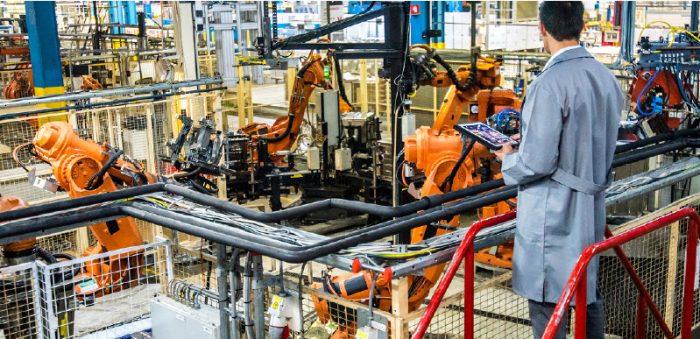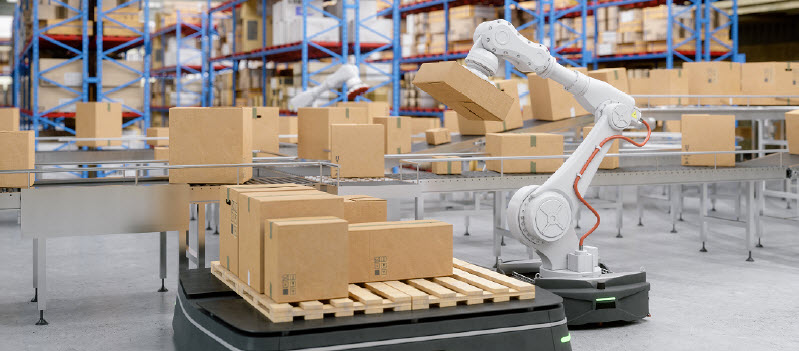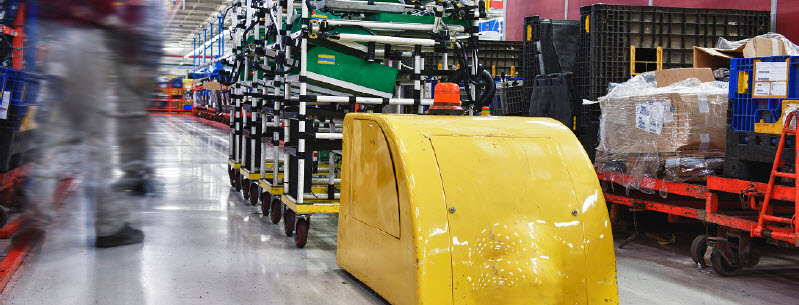FTM / Connectivity / TE Connectivity – 4 Hardware Trends that are Driving the Evolution in Warehouse Automation
Each quarter, new technologies are launched that make automation easier, more efficient, and more attainable for even small operations. The growth and acceptance of lithium-ion battery technology, for example, has revolutionized the efficiency of electric vehicles and robots and helped make miniaturization possible, thanks to the batteries’ compact size and energy storage capabilities.
Yet there are several other important but lesser-known innovations advancing warehouse automation. These unsung heroes can be found in the hardware that makes warehouse automation run. In fact, upcoming hardware trends will help drive the next evolution of warehouse automation. We take a closer look at four hardware trends worth watching.

Advancements in lithium-ion battery technology have made it possible to pack more energy into a smaller envelope. Known as “energy density,” the effort to increase energy storage capacity while decreasing size has been a top priority for battery and fuel cell manufacturers. A close second is the effort to make energy storage and use more efficient. As it turns out, one system is critical for achieving both goals: the battery management system (BMS).
Think of the BMS as the brains of the battery — it determines how the battery supplies power, how it recharges, and how it distributes power from the cells in the most efficient way. Typically, the BMS is embedded within the battery pack of a vehicle (an electric forklift, an automated mobile robot, or an autonomous guided vehicle). While battery health, power, and charging status are the most common things for the BMS to track, it is not unusual for the BMS to be paired with telematics and used to monitor temperature and workloads as well.
“The BMS is the decision-making system for the battery; it decides how efficiently to distribute and recharge the battery power,” says Ricardo Hernandez, industry sales manager at TE Connectivity (TE). “The big trends we see nowadays are manufacturers differentiating themselves by how quickly their battery recharges and by the intelligence of their BMS to make smarter, more efficient use of energy.”
A smart BMS requires smart connectors for power, signal, and data. If the BMS is the brain, then the connectors are the blood vessels and nerves providing the necessary inputs for the BMS to make intelligent decisions. Therefore, having connectors that allow for a smooth, seamless flow of communication between the devices is critical.

For many manufacturers, interacting with their suppliers can feel as automated as the warehouse they are operating. And that is unfortunate, because the “real magic,” as Ricardo Hernandez calls it, is in the problem-solving and solution-building that comes when engineering teams from the manufacturer and the supplier work together. That is how TE approaches it.
“We are supporting our customers with engineering experience,” says Hernandez, TE industry sales manager. “Too often what happens in this space is that our competitors come in and say, I have a connector and this is the part number, this is the catalog where you can find the specs, and this is my price for X quantities. Whereas at TE, we consider ourselves as part of the customer’s engineering solutions team. We do not consider ourselves just a component supplier because that is a transactional relationship. We are engineering with our
customers and truly understanding their application.”
Beyond TE’s reputation as a connector company, there is also deep expertise on sensor solutions, electrical systems, and relays. What unites all of these areas — and where the company truly thrives — is in its extensive work in heavy-duty industrial applications.
“We are a market leader in this space; that is who we are,” Hernandez says. “You are going to get one of the best connectors and one of the best value propositions for your application.”
At some point in the near future, the warehouse charging room will be a bygone relic, occupying that same “remember when” space in people’s memories as the rotary phone and the audio cassette tape. As lithium-ion batteries overtake the old-fashioned lead-acid models, there will no longer be a need for warehouses to reserve a room or space for forklifts and empty batteries to be parked for eight or nine hours to recharge. Instead, opportunistic charging will be the norm, where a forklift, mobile robot, or AGV can simply plug into the nearest charging station and get a full charge in 15 to 30 minutes.
Yet, there is an unseen innovation lurking within the larger trend of opportunistic charging: the push for more resilient cables and connectors. Why? Because opportunistic charging enables many more mating cycles per day than traditional charging methods.
“The connectors that have been used for many years in the industry were designed for you to charge once a day for eight hours,” Hernandez says. “Now, with opportunistic charging, you are charging five to six times a day. Then multiply that by shift, by equipment, by day, across the warehouse. It becomes very challenging. These connectors were not designed for that.”
Unfortunately the solution is not as simple as making a tougher connector and cable that can handle more mating cycles. Not only does the connector have to withstand more mating cycles, it also has to transmit more current. Thus, engineers are working on an outstanding type of connector technology that offers a high mating cycle count without sacrificing power and also tolerates the harsh industrial environment. It requires marrying technological innovation with user-friendly ergonomics.
“When you go to plug in your electric forklift, how do you guarantee that it is fully connected?” Hernandez asks. “How do we avoid issues of people getting hurt? We embed ergonomics. We make it easier for the person to connect these stiff cables and big connectors. It has to be easy.”
A promising trend for future warehouse automation efforts is wireless charging opportunities for electric forklifts. Wireless charging could solve safety issues, decrease maintenance costs, and allow for unlimited mating cycles, among other benefits. But how close are we to making wireless charging a reality?
“Companies are working tirelessly on increasing the wireless power transfers to make it applicable in warehouse automation,” says Daniel Walldorf, project manager, innovation platforms and ventures, at TE.
One of the biggest challenges to overcome is the limited power. A large forklift today is charged with 10kW to 25kW. Most wireless charging systems only offer 1kW to 3kW, which is enough for smaller vehicles but
not larger ones. “But the development for these systems is very dynamic, so it is probably only a matter of time until this is solved,” he says.
Another challenge is that wireless charging systems require a large surface area on the vehicle. For instance, a 3kW system needs about 25cm x 25cm of space on a forklift. This is not a problem on a large forklift, Walldorf notes, but it limits the use for smaller autonomous mobile robots (AMRs). “This is a much more conceptual problem that will be more difficult to solve,” he says.
What wireless charging will offer:
• Reduction in maintenance needs
• Virtually unlimited mating cycles
• Essentially no limitation on docking direction
• With some technologies, it could enable dynamic charging (charging while the vehicle drives)
• No contacts exposed to the environment, which would be important in cold chain or outdoor applications
• Flush design is possible — which would be important for areas where food is handled or in clean rooms
TE supplies its Dynamic Series connectors to wireless charging connector makers who need an efficient and reliable connection solution for their systems.
While there are challenges to simplifying manual charging, the logistics behind autonomous charging are truly daunting. An autonomous vehicle docks itself when it needs a charge. There is no human to guide the connector into place.
“If you have a person connecting these things that is a little easier because the person is using their hands and their eyes to go, ‘OK, how much force do I need? I know I am aligning these pins together,’” Hernandez says.
But with autonomous charging, it is on the automated system — the sensors, motors, drives, connectors, and more — to make sure it goes right. Plus, there are all the aforementioned requirements for higher power levels, fast charging, and heavy-duty mating cycles. And do not forget: This charging takes place in a lessthan-
perfect environment.
“The floors in these warehouses are not neat and they are not even,” Hernandez notes. “So you can have situations where the vehicle is bouncing all over the place, or maybe rolls over a piece of cardboard and it is not going in a straight line to be perfectly mated to the charging dock. It is the nature of the application.”

The automated warehouse of the future will include both manual charging and autonomous
charging options. One technology will not replace the other, says Hernandez; they are both needed
for redundancy.
“I do not think manual charging is going away at all; I think it is just going to be another fail-safer option in case you cannot use automated,” Hernandez says. “We are engaged with the market leaders in this space and they tell us redundancy is important. You do not want to depend on one single type of charging. Maybe your self-docking charging stations are all full or maybe one went down but you still have to recharge. You want to have that ability to have redundancy. There has to be an option for both.”
To overcome the variables in the physical environment, engineers build tolerances into the vehicle’s system that allow for a charging connection to be safely made even when it is not perfectly aligned.
“We develop technology that allows for that misalignment to not be a problem,” Hernandez says. “From a technology perspective, it is a very big challenge but we consider ourselves a market leader in this space, solving issues that are noteworthy to this industry.”

Interoperability is a buzzword across a number of industries. As a trend in warehouse automation, the term reflects the rising demand for platform-agnostic charging connectors, cables, and stations.
Unfortunately for end users, that is not an option today. Each brand of forklift, autonomous mobile robot (AMR), and automated guided vehicle (AGV) has its own proprietary charging connector and they are not cross-compatible. While it might not be an issue for smaller operations that use just one brand of equipment, it is a real problem for large warehouse operations that employ entire fleets of multiple brands.
“Now, all of a sudden, in order to manage my warehouse, I have two or three different brands of forklifts,” Hernandez says. “And if I have three different brands of forklifts, that means that each forklift has a different connector, three different cables, three different charging stations, and you are paying for each. Now imagine you are a company like FedEx, which has a huge operation globally with thousands upon thousands of forklifts in all of their locations. You can just imagine the amount of charging stations they have to manage and why they are saying interoperability is key.”
TE is working alongside other companies and trade groups to advocate for a set of standards that push for more cross-compatibility between brands.
“We want to make sure that we do our part as a hardware supplier to enable these companies to use just one connector and make it easier for the end user to have one charging station to charge the whole fleet,” Hernandez says.
Beyond making charging more user-friendly, interoperability will also allow AMRs from different brands to share status information, operational conventions, and other details that will help make warehouse automation more efficient and unlock further innovation.

The macro-level trends driving the demand for warehouse automation show no signs of slowing, so technological innovations will have to keep pace.
TE is committed to advancing the hardware and connector technology needed to driveautomation and brings deep experience to industrial applications. Our customers aremarket leaders who rely on TE engineers to advance their warehouse automation goals.We provide connectivity solutions that support virtually uninterrupted operationsand the use of AI, contactors, and connections that help manage battery and power
systems while also meeting the needs of new autonomous charging capabilities. We produce an extensive breadth of sensors, relays, and connectors to help make smart automation possible.
Ready to take your warehouse automation to the next level?
Leverage high-speed connectivity capabilities, application-focused engineering expertise, and one of the broadest product portfolios in the world with TE Connectivity. We make it easy to connect with our experts and are ready to provide all the support you need. Visit te.com/support to chat with a Product Information Specialist or explore TE’s product portfolio.
Be at the forefront of New Technology Innovations
Be at the forefront of New Technology Innovations
© 2024 Future Electronics. All rights reserved. Privacy | Terms & Conditions of Sale | Terms of Use | Accessibility